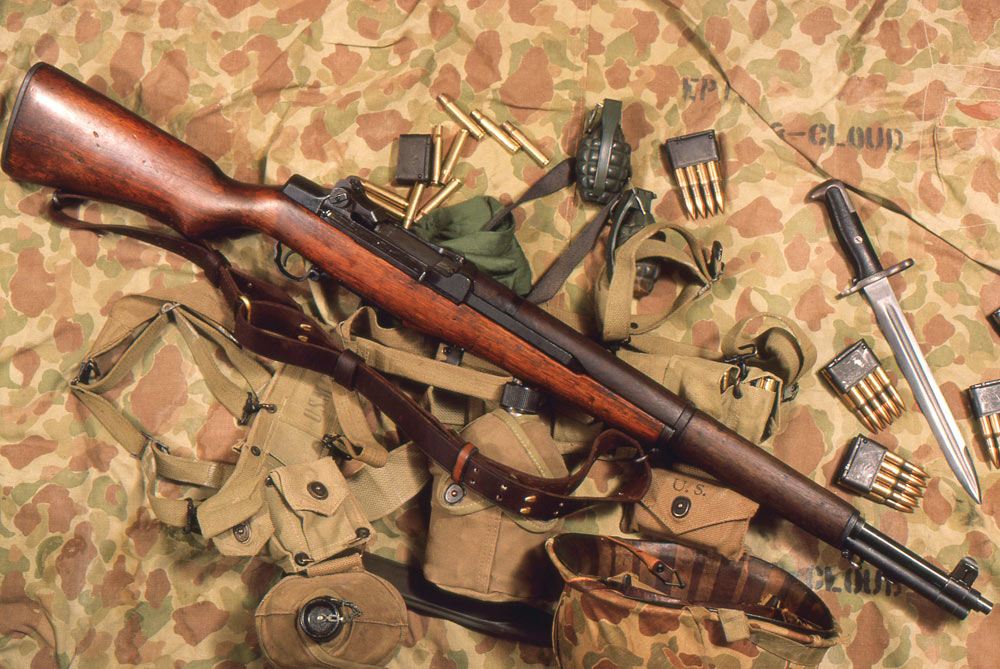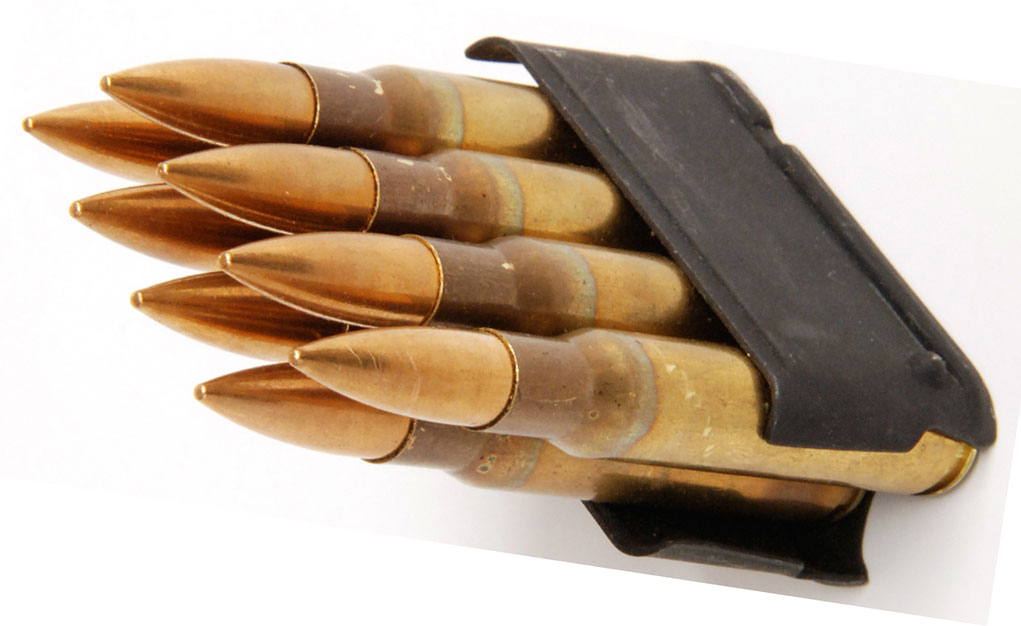

Built like a Sherman tank, accurate to 1,000 yards and available on the surplus market, the battle-worn M1 Garand still soldiers on.
What makes the M1 Garand the “greatest battle implement ever devised”?
- The M1 Garand was the first semi-auto rifle issued to American military personnel.
- The rifle is a long-stroke gas-piston-operated firearm, similar to the AK-47.
- The M1 Garand's operating handle doubles as a forward assist.
- The M1 is top-loaded, fed with an eight-round clip of .30-06 Sprg. ammunition.
- Its magazine can be topped off; however, this is not recommended.
- The M1 weighs between 9.5 and 10 pounds, depending on the wood used for the stock.
The M1 Garand is perhaps the most storied battle rifle in U.S. history, having stormed the beaches of Normandy and Iwo Jima. It was a cornerstone to America's victory in Europe and the Pacific and hold a revered place in soldiers' and shooters' hearts.
The grand M1 is still available today and not only makes a unique addition to a collection, but also provides endless hours of enjoyment. The Garand is a competent target rifle, has been used to take more than one deer, and is a solid survival option if need be. And yes, you can still purchase one.
Here's what you need to know about the M1 Garand if you're in the market for the old warhorse.
Table Of Contents
Rifle Basics
History
Clips Vs Mags
Operation
Gas System
Production Figures
Maintenance And Disassembly
Sights
Shooting
Buying An M1
M1 Garand Basics
The M1 Garand, generally chambered in .30-06 Springfield, was the first semi-auto issued to American fighting men when our enemies and allies were still carrying bolt-action rifles little different from those of World War I. This revolutionary design was adopted by the U.S. Military in 1936 after more than a decade of development and even then saw some key changes before ending up as the rifle carried to victory in WWII and Korea.
In fact, the M1 Garand was so successful that it continued to see use in Vietnam and with reserve troops into the early 1970s, although it had been officially replaced in 1957 from front line service. Even then, the Garand was still in use with the militaries of a dozen friendly nations that we equipped, including the Greek Army well into the 1980s.
The M1 can weigh between 9.5 and more than 10 lbs. empty, depending on the type of wood used. Add a sling and buttstock cleaning kit, and the scale tips up. Of course, this much weight soaks up a lot of recoil, which helps with weapon fatigue and faster follow-up shots.
M1 Garand History
Designed by Canadian-born John C. Garand, a long-time Springfield Armory engineer, the rifle that bears his name is a long stroke, gas piston-operated, eight-shot clip-fed semi-automatic rifle chambered in the same .30-06 cartridge as its predecessors, the 1903 Springfield and the M1917 Enfield.
The long-stroke piston on the M1 is like that found on the AK-47 and constitutes a long steel operating rod that is one piece with the charging handle and joins the rotating bolt, which features two locking lugs on its face.
When firing, the operating rod, handle, and unlocked bolt move back as one unit, improving the rifle’s reliability in field conditions but also negatively affect precision accuracy. In addition, the bolt handle can serve as a forward assist to properly seat a round. Nevertheless, the M1 was considered very accurate and was used in the sniper role with scoped variants as well as in modern competition.

It is possible that Mr. Garand may have come up with different features on his rifle if left to his own devices, but the terms that the military contract called for set the stage. The most off-putting feature to our modern eyes is undoubtedly the clip mechanism, which was demanded instead of a removable magazine.
Clips or Mags?
Although many people use the terms interchangeably, a clip and a magazine are not at all the same. A magazine holds the ammunition to feed into the gun; a clip holds the ammunition to be loaded into the magazine.
The M1 has a fixed internal magazine, which is fed from the top by a spring metal clip holding eight rounds. Without the clip, the M1 becomes a single-shot weapon with the shooter only being able to load one round at a time.
The eight rounds are staggered in the clip, and there is no top or bottom, so it doesn’t matter on which side the top round is located (which is handy for a battle rifle). On the last round fired, the clip automatically ejects, and the bolt locks to the rear.
Retracting the bolt and depressing the clip latch located on the left side of the receiver manually ejects a full or partially full clip. Magazines can be topped off, but this is not easy or recommended, and it is far better to eject a partially expended clip and replace it with a fresh one. Both 2- and 5-round clips are commercially available.
M1 Rifle Operation
Operating the M1 is simple, but takes a bit of practice at first. Once the bolt is locked to the rear, a full clip is inserted through the top of the receiver and pressed down. The bolt then automatically releases to go forward and load the first round. It is best to do this with the thumb of the right hand while using the palm to hold back the bolt handle, otherwise the bolt could slam onto your thumb with some force, causing the infamous “Garand thumb.”
Moreover, the safety catch is somewhat novel and reminds me of those found on SKS rifles. To engage the safety on the M1, depress the metal catch in front of the trigger guard toward the trigger. This moves the steel tab into the trigger guard, partially blocking access to the trigger.

When you are ready to fire, simply place your finger on the trigger and push the safety bar forward and out of the trigger guard area.
M1 Garand Gas System
The final gas system adopted for the M1 uses a hole in the bottom of the barrel toward the front of the rifle to divert gas against the front of the operating rod.
The short gas tube located underneath the barrel at the front was made from stainless steel to prevent corrosion; it was then painted black since the stainless steel would not be easily Parkerized. This accounts for the difference in finish of this part from the rest of the rifle. It should also be noted that a lot of military .30-06 ammunition is corrosive because it has sodium in the primer and requires the use of water to clean properly and prevent rust.
Garand Production Figures
During World War II, Springfield Armory (the government armory not the Springfield Armory we know of today) and Winchester Repeating Arms produced approximately five million Garands. After the war, another nearly 1.5 million were produced by Springfield Armory, Harrington & Richardson Arms, and International Harvester Corporation.
Almost every M1 has undergone some sort of arsenal repair or rebuilding, which often included new barrels and replacement parts from different manufacturers. Even Beretta produced Garands using Winchester machinery after the war, and Beretta parts can be found on M1s imported from service with European armies.
I have owned several, all purchased through the Civilian Marksmanship Program or CMP. These differ significantly from M1s that may have found their way back to the U.S. from commercial importers.
That’s because CMP guns are all genuine U.S. Government surplus that have been inspected, repaired and test fired by CMP armorers and are free of those annoying import marks.
Maintenance And Disassembly
Maintenance and disassembly of the M1 Garand is straightforward, although at first glance it does seem like there are a lot of parts to keep track of; of course, they must be reassembled in the correct order, too. Also, it is best to assume that any ammunition you use, except for modern commercial stuff, is corrosive — requiring you to clean accordingly.

M1 Sights
The front blade sight is fixed, but the rear peep is outstanding with elevation adjustments in 25-yard increments out to 1,200 yards with easy windage adjustments. Mounting a scope on a Garand is no easy task and in order to keep the rifle as close to original as possible it's best to stick with iron sights.
Shooting the M1
This is a large, heavy rifle, and I can’t say that I would have relished having to carry it in combat. It is easy to understand why a lot of American soldiers preferred the M1 Carbine. Still, the rifle is very well balanced, shoulders easily, and the recoil — even with the full-sized .30-06 battle round — very manageable.
Accuracy on the range firing at 100 yards from a bench rest and using the standard iron sights was very good — as good as most of the scoped ARs I shoot. My best group was an impressive 1.4 inches using Remington ammo, but the Greek 1980s vintage surplus stuff also produced a 1.4-inch group.
Keep in mind that this is out of a WWII vintage, semi-auto, beat up, rebuilt, Greek loaner rifle using ammo that was made in Greece when Jimmy Carter was president.
Many variants of the M1 Garand were created during and after the war, including a never-issued tanker and paratrooper model as well as select-fire versions and ones with detachable magazines. Some were also chambered and issued in 7.62x51mm NATO (.308 Winchester), especially once the .30-06 round was phased out.
M1 Garand For Sale
The best place to get a real American M1 Garand is still through the CMP, and they have various grades available, although supplies are dwindling. Rack Grade guns are the cheapest and have the most replacement parts and wear. Criteria for purchase is easy to meet, and CMP ships the rifle directly to your door.
Given the interest in the rifle, away from CMP, Garand prices have soared. At gun shows, it's not unusual to find a common model, such as one from the Springfield Armory, draw in excess of $1,000. Rarer and more collectible ones, such as International Harvester M1 Garand, demand a premium price, even in rough shape.
U.S. M1 Garand .30 Caliber Specifications:
Caliber: .30-06 Springfield
Barrel: 24 in.
Overall Length: 43.5 in.
Weight: 10.5 lbs. empty
Stock: Walnut
Sights: Fixed blade front, adjustable peep rear
Action: Semi-auto
Finish: Parkerized
Capacity: 8-round clip
Price: $525
256-835-8455
www.odcmp.com
Editor’s Note: This excerpt is from Modern Survival Guns: The Complete Preppers' Guide to Dealing with Everyday Threats Elwood Shelton contributed to this post.
Dig Deeper into the M1 Garand:
- M1 Garand Ammo: What Should You Shoot in Your M1?
- M1 Garand Bayonet for the Ultimate Survival Gun
- M1 Garand Clip Loading Basics and Troubleshooting Tips

Next Step: Get your FREE Printable Target Pack
Enhance your shooting precision with our 62 MOA Targets, perfect for rifles and handguns. Crafted in collaboration with Storm Tactical for accuracy and versatility.
Subscribe to the Gun Digest email newsletter and get your downloadable target pack sent straight to your inbox. Stay updated with the latest firearms info in the industry.

![Best Concealed Carry Guns In 2025 [Field Tested] Wilson Combat EDC X9S 1](https://gundigest.com/wp-content/uploads/Wilson-Combat-EDC-X9S-1-324x160.jpg)


![Best 9mm Carbine: Affordable PCCs [Tested] Ruger Carbine Shooting](https://gundigest.com/wp-content/uploads/Ruger-Carbine-Shooting-100x70.jpg)
![Best AR-15: Top Options Available Today [Field Tested] Harrington and Richardson PSA XM177E2 feature](https://gundigest.com/wp-content/uploads/Harrington-and-Richardson-PSA-XM177E2-feature-100x70.jpg)

The M1 Garand is an American semi-automatic rifle featured in all World War II
Bought a high quality mags at https://raeind.com/
have used a m1 garand rifle 30-06 cal. for a whole lot of years as a moose hunting rifle i didnt find anything finicky about it. its a one shot one kill rifle and i have killed a lot of moose thru the years with it and i used what ever ammo i could find at canadian tire it never failed me and its is still going strong.
$525 for a CMP Garand! The writer really ought to do his homework before putting out such drivel.
The Garand is ridiculously expensive, heavy, has few modern accessory options. It is sight limited, per the US Army manual, to 460 yards, so I have no idea where claims of 1000 come from. I may as well claim the Mosin Nagant is accurate to 2000 because the sights adjust that far.
It was the “finest implement of battle” in the opinion of one man in 1943. That’s three generations ago. You may as well cite the greatness of the Studebaker Coupe.
It’s finicky as to which ammo it takes, unlike a bolt action, and much of the off-the-shelf hunting ammo will damage it. That ammo is heavy and limits loadout. The clips are intended to be one-time use, and while they can be recovered, they get scattered across the landscape in use, making that more complicated in any kind of non-fixed engagement. When they are gone, you have a single shot rifle. (Box magazines can be disposed of, but can also be returned to a pouch for re-use.)
In other words, even with inflated claims to its greatness, it is just about the worst possible choice for a survival rifle.
Why include photos of the M1 carbine? Better would have been a photo of the M1 rifle, with the bolt locked open, showing the follower, the positioning of the clip for loading, and perhaps a short video of loading a clip, and then how to use the clip release. It’s very familiar to those of us who were issued M1s, in the early 60s Corps, but the writer sound as if he’s never actually handled one. The remark that the long-stroke operating system negatively affects accuracy, is inaccurate. The op rod moves to the rear independently, after the bullet passes the gas port in the bottom of the barrel, about 1″ from the muzzle. By the time the bolt starts to unlock, the bullet has left the muzzle, so what happens after that is irrelevant. NM prepared M1s, which I have fired from 600 yards, are known ‘tack drivers’, and will easily group NM Frankford Arsenal ammunition within the V-ring at that range, and beyond. Even a standard issue M1 will do that at 500 yards, with nothing more than proper sight alignment, sight picture, and trigger control.
very good information sharing